You’ve done it; you’ve reached $50 million in ARR. When you’re at 0 working towards your first million, that number almost feels like an impossible milestone to reach. But when you get there, perspectives and realities change once again. Now you’re trying to hit $60 million and eventually $100 million.
In this panel, Tien Tzuo, Founder & CEO of Zuora; Aaron Skonnard, CEO at Pluralsight; Nitsa Zuppas, CMO at Veeva Systems; and Scott Dorsey, Managing Partner at High Alpha, discuss the big changes that companies face as they hit that $50 million mark and how to navigate them.
They talk about the importance of having people on your team who have gone past your current phase to help you scale. Not only that, but pricing isn’t really about cost, it should be determined by the value you can communicate to your customers. The bigger you get, the harder it is to keep a finger on the pulse of what’s going on with everyone in the company as a CEO, so you always need to keep the lines of communication open.
And if you haven’t heard: SaaStr Annual will be back in 2018, bigger and better than ever! Join 10,000 fellow founders, investors and execs for 3 days of unparalleled networking and epic learnings from SaaS legends like Eric Yuan, Tomasz Tunguz, Chris O’Neill, and Mikkel Svane. If you don’t have tickets, lock in Early Bird pricing today and bring your team from just $999! (All ticket prices go up December 1st.) Get tickets here.
TRANSCRIPT
Announcer: He was Chief Marketing Officer and Employee 11 at Salesforce. He left to champion the subscription economy at Zuora. Please welcome the CEO of Zuora, Tien Tzuo.
Tien Tzuo: Good afternoon. Welcome back from lunch. Thanks for joining us. Got a really exciting panel here. I was in the audience looking at the stage. Growing up in New York and trying to sneak into these “David Letterman” shows, this is my David Letterman moment.
I’ve got the mug, I need a pad, I’m going to be throwing stuff, pencils out at you guys.
We’ve got a great panel here. Let’s bring them out, and let’s get the talk going.
Nitsa Zuppas: They must think we’re going to be hugely thirsty.
Scott Dorsey: Yeah, we’ve got two cups.
Nitsa: How long is this panel? [laughs]
Tien: All right. Well, in picking up to the theme from the panel right before the lunch and the theme of this conference, which is all about scale. We saw the panel before talking about 20 million, 30 million, and we want to take it up a level.
In fact, this panel is supposed to be about 50 million. Those guys covered a lot of stuff. We’re going to take it all the way to 100 million. We’re going to be talking about what happens after the companies that you heard about when you’re hitting $50, $60, $100 million.
Before we do that, let’s go ahead and let the panelists introduce themselves. First up, we’ve got Scott Dorsey who I’ve known for, gosh, probably 15 years since he was one of the Salesforce’s early partners, but built an amazing company. Why don’t tell us a little bit about that, what size? It got pretty big. What are you up to now?
Scott: Great. Hi, everyone. Delighted to be at SaaStr and applaud all of you SaaS entrepreneurs that are out building tremendous companies. I had just a really blessed experience founding a company called ExactTarget in Indianapolis, Indiana in 2001. Go Indy.
[applause]
Scott: All right, pretty good local crowd. We built the market leader in email and digital marketing and just had an extraordinary experience going from three first time founders, starting in the world of SaaS, to ultimately building the largest marketing software company in the space. We just had a tremendous experience.
We ended up going public in March of 2012, and then in summer of 2013 sold to Salesforce for 2.5 billion, which was really tremendous.
I was fortunate to stay onboard with Salesforce for about 15 months, leading the Salesforce marketing cloud. It felt like I learned so much from startup to the point where we sold the business. I learned even more being a part of Salesforce.
About two years ago, along with some great partners and friends, we started a new venture called High Alpha in Indianapolis. We describe High Alpha as a venture studio.
We’re one part startup studio, starting new enterprise SaaS companies, and one part venture fund where we’re investing in early stage SaaS entrepreneurs within our studio and outside our studio.
I feel very blessed to have an opportunity to go back to my roots, and work on early company formation and startups, and investing and supporting many great SaaS entrepreneurs all throughout North America.
Tien: Great. Good. Let’s move to Nitsa. You guys hopefully heard the amazing talk from Peter Gassner this morning. He’s built an amazing company.
One of his trusted lieutenants is here today to talk about what it felt like, the inside story of how to grow. Nitsa, why don’t you tell a little about that and maybe a little about your background at Scopus and Siebel, which I think is very relevant here today.
Nitsa: I’ve been in enterprise software for a little while and very early in the CRM market, when actually it was just call center and sales force automation and marketing automation actually hadn’t even happened yet at a company called Scopus.
I was at Siebel Systems for about 10 years through that very, very high growth period, so I was very fortunate with that. Took a little side track and then a number of years ago early on at Veeva, before the company went public, joined as CMO.
We are focused on building the industry cloud for life sciences. When the company started in 2007, this idea of industry cloud was a relatively new idea. We think that it’s actually one of the largest segments.
Gardner says it’s actually the largest segment of enterprise software is industry specific software. Many of these industries are stuck on aging legacy systems because there isn’t software that’s specific enough to meet their needs.
We started with life science’s specific customer relationship management and then expanded from there to content management to master data management and then industry specific data.
The company has experienced really remarkable growth where it’s roughly approaching about a $600 million run rate. We have a path to get to $1 billion run rate in 2020, and so it’s been a really incredible growth story. [laughs] Again, that I’ve been very fortunate to be a part of.
Tien: Public for three years?
Nitsa: Yeah, just over three years.
Tien: Amazing success story. Good. We’ve got a little bit of geographic diversity here. Bay Area, Indianapolis, and now Salt Lake City. Aaron’s built an amazing company over the last 10 plus years. Why don’t you tell us a little bit about that?
Aaron Skonnard: We’re just north of Salt Lake City, in Utah. We’re getting some great snow this year, which is awesome.
Pluralsight is a company that’s really focused on what we see as one of the world’s biggest challenges right now, which is filling the tech skills gap. Every business in the world has technology needs, to really drive their future strategies forward, and create their innovations.
The way we see ourselves as a company is we create the creators. We create the technology skills and the professionals that our businesses need to create the creations we have for the world, that improve and lift mankind. Our mission at Pluralsight is to create progress through technology that lifts the human condition.
That’s how we think about it, and we’re really committed to that. We really believe in it. We believe in the good that technology does for the world. It started out as a small, little company, focused on doing that in the classroom. We actually applied technology to our own business, to transform it and disrupt it, to take it to the world through a digital format.
That’s been the progression for us over the last 13 years. We have about 550 people at Pluralsight now. We’re between 100 million and 200 million in revenue, and growing quickly, and just have an amazing team.
Ultimately, we’ve gone through a lot of transitions just over the last couple of years that we can talk about today. It’s been a lot of fun.
Tien: Good. Super exciting. I don’t know about clicker. Can we move to the next slide? Perfect. 400 million, 500 million sold to Salesforce. 600 million, going into a billion. We heard from Aaron, over 100. Zuora here, we’re about 600 employees, and over $100 million run rate, as well.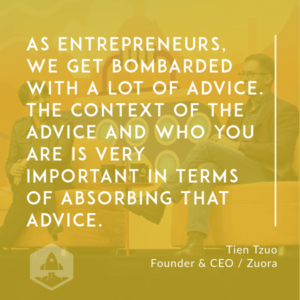
What we want to focus on is, there’s so many entrepreneurs in the audience, and you guys all come here to SaaStr for the community, and for advice. As entrepreneurs, we get bombarded with a lot of advice from different folks. What I found was the context of advice, the context of who you are is very important, in terms of absorbing the advice.
You’ve got great folks, great intentions, give me advice, that maybe applies to a later stage company versus the earlier stage company. Just as a visual way to think about it, it’s good to break up a company into different phases, to use the threes and ones, if you will.
You go from zero to one million, one million to three million, three million to 10, 10 to 30, 30 to 100. 100 to 300, and hopefully it’s up to $1 billion. You can see the conferences arrange with that structure. What we really wanted to talk about today was, what does it feel like in that $50, $100 million range? We’re going to talk about three areas.
We’re going to talk about go to market and business models, if you will. We’re going to talk a little bit about, what do you do with the product and the technology? Perhaps there’s a second act. We’re going to talk about the organization.
Let’s start with go to market. You wake up one day, you go through years of hard work, and congratulations. You’re 50 million, you’re 60 million, you’re 70 million.
You look at the next hill, and the next hill looks even bigger. How do I find the next $50 million of revenue? What big break points did you guys have to come to, in terms of, “How do I now change my go to market?”
You go through this phase of really selling anybody, and selling every single customer. Did you guys have to find a second act? Did you have to fire certain customers? How did you guys all think through that? Let’s start with Scott.
Scott: I’ll go first. Our story is an interesting one, in that we filed to go public in December of ’07. The equity markets really crumbled in ’08, and we ended up having to pull our filing, and a couple of years later, give it another push. What was interesting about our filing in December of ’07 is we were exactly a $50 million company.
I went back and refreshed my memory a little bit on ExactTarget at 50 million. Exactly as Tien described, we had great product market fit. We were growing quickly. We were really selling email marketing solutions to small and medium sized businesses, but we hadn’t developed, “What are the next growth levers to take us from 50 to 100, and well beyond?”
We built a growth framework, and we really focused on three areas. The first was segmentation, where we were moving up market. I think it’s a really strong path for many SaaS companies to start in the small and mid market getting traction, proving your value, delivering happiness to your customers.
Over time as you build more and more capabilities and a services org, you can really stretch up market and start to serve the enterprise which is a real game changer for your business. Growth lever one was really moving to the enterprise. Growth lever two was international expansion.
At the time we were only two or three percent of our revenue from outside of North America. International expansion became a big growth driver for us. Three was M&A and product expansion, moving from one product to a multi product strategy.
That’s really the growth framework we had, moving to the enterprise, expand internationally, and then move from a single product to a multi product company.
Tien: Did you have to exit any customer segments or it was all layering on top additional things?
Scott: From a product perspective?
Tien: Just from a go to market perspective, did you look at your customer segments and say, “Hey, here’s the ones that were more profitable. Let’s focus on that. Let’s de-focus on those things.” You were more across the board.
Scott: It was interesting. Later, we became very granular about customer profitability by size, by segment, by vertical. [laughs] What was really most interesting was that the mid market were our most profitable customers. The little guys cost quite a bit to support.
The really, really large enterprises were very heavy from a pro services perspective. Our sweet spot was mid market. The enterprise was so important for us to drive big topline growth and then landing the big logos gave us air cover for the rest of the business.
Tien: Right, good. How about Veeva?
Nitsa: I think picking up on where you left off around multi products or what do you do if you find yourself in a situation where you’ve typically sold one product to one line of business buyer through a lot of founder heroics?
What you really need to start thinking about is the sales capability, first and foremost, to be able to sell multiple products, have a broader value proposition and sell higher. Sometimes you can take those sales people that you have and you can bring them up to that level. Sometimes you need to look for new talent.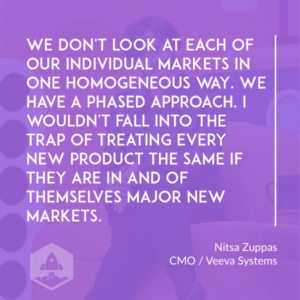
Also, we don’t look at each of our individual markets in one homogeneous way. We have a phased approach where we look at those products that are, let’s say, in phase zero. The question that the market has for you at that point is, does it work? Because you haven’t sold it to anyone, you don’t have any referenceable customers willing to stand up.
The things that we do there, now again we’re in enterprise software, is we make sure we get a few early adopters, live, happy, widely referenceable. We focus on thought leadership, aligning ourselves with people who will make us, we call it standing on the shoulders of giants, give us credibility in that segment.
Once we have that referenceable base, we go into the second phase, which is, OK now you have a few reference customers willing to say, “Yeah, it works.” The biggest question the market has for you at that point is, “Yeah, I know it works, but is it important?” You go and scale out your demand gen, your sales effort.
You’re still attaching to shows and other things, but you really are trying to get yourself still in every RFP. You move to a leadership phase. You have most bellwether accounts. You’re the default on every RFP. You’re not going to miss out of there. You don’t really need to do as much of that.
You are the market. You make the market; you tend to be the show. You don’t have to attach to so many things. At that point, it works. I know it’s important, but it’s not new. What do you do?
Certainly, I know in SaaS, we say we’re rewriting that story. I think it’s really, really important to think about then leadership and where you’re taking the market.
I wouldn’t fall into the trap of as you’re starting each of these new product areas, if they really are in and of themselves major new markets, to treat every single one the same. Make sure that you have a clear understanding internally of that. Sales knows what to expect. Marketing knows what they need to do. Market owners know what they need to do at each phase.
It’s very easy to get confused when you’re in phase zero just trying to sell to early adopters that you need to do all of these, let’s say, demand gen. Well, you can’t even support that demand because you can’t provide sales references.
Tien: So many companies…I was talking to the CEO the other day, did a bunch of acquisitions of find that second product. It never really clicked. By the time you get to 50, 60 million, you forget almost what it was like to sell that initial product and having a formal language around this to understand, though, this is a phase zero product.
Think like a startup. Don’t think like a $50 million. It’s critical.
Scott: Yeah.
Nitsa: That’s a really interesting thing. In our growth plan, literally, where we have each of these markets, we have what phase it’s in and we have what priority it is. You’re not confused if you’re a priority two or you’re a priority one and if you’re in phase zero, one, two or three.
Aaron: I think when you’re smaller, you’re not even really thinking about those things at that level. You’re not really stopping to write it down and actually get your corporate strategy in a format that the whole company can digest and understand simply.
As you’re working through the business and making those decisions, you have a framework through which you can make those decisions. That for us came later when we were well beyond 50 million of revenue.
I want to say something else to enterprise. I think Scott laid out a great framework of how the three big areas that you think about. We had a very similar experience. We’re having it right now. The enterprise move, into that adjacency, we’re in the middle of that right now. I just want to say it’s harder than any of you currently can see.
If you haven’t gone through it yet and you’re about to go through it…I remember how I felt when I saw it. I thought, “Oh, that can’t be that hard.” We have an amazing product. It was land and expand. We’re getting it into mid market pretty successfully. I thought how hard can it be to just go up market to the enterprise?
Well, I’m here to tell you that it’s guaranteed to be harder than you currently think it is.
Tien: Any lessons? Any lesson for the folks that are…?
Aaron: Yeah, the lessons that I learned was I didn’t know what good looked like. I didn’t know what success looked like at that moment in time. I was living in this land and expand model. We had an amazing product. People wanted our product, but we were not going in and selling in the enterprise way, really, truly selling in a consulted…
Tien: Challenges sales?
Aaron: Yeah, in a consultative way where you’re really selling value, you’re really changing your messaging. There’s a lot around that that as a founder, as a CEO, I didn’t see at that time. I really didn’t know what good looked like.
It wasn’t until I really committed to that pivot and really went out and found people, and especially leaders, that could come into my business and knew what it looked like, and could come in and actually teach the rest of the organization that, that things really started to change.
Tien: Would you talk about as you look at some of these public SaaS companies now that are trying to go up market as a public company and they’re selling a lot of doubt with the street about their ability to do that, put that DNA and inject that into your organization.
Aaron: For me, I decided I couldn’t go public until I figured that out. That to me became a showstopper. I wanted to make sure we had the foundation. That lever was so important for us in the long term growth strategy that we had to get it nailed first.
Scott: That was part of our story also. It was actually a huge blessing that we couldn’t go public in that ’07, ’08 timeframe because we were just starting to test the waters in the enterprise. We really didn’t know what was ahead of us.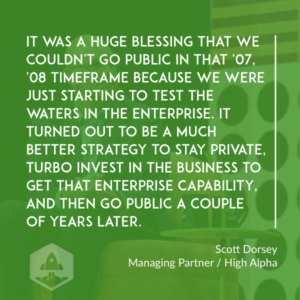
It turned out to be a much better strategy to stay private, be able to turbo invest in the business to get that enterprise capability, and then go public a couple of years later. For us, the enterprise surprises were just not only on the product scale side of the equation, but all kinds of areas you don’t expect.
Professional services, security audits, inspection of your HR hiring practices, just everything from top to bottom of what you build is really required to get to the next level to serve the very large, very demanding enterprise, so there’s a love of organizational maturity that becomes really important.
Aaron: Exactly. Your cost model is shifting out underneath you, as you’re going, because in the land and expand model, it’s actually pretty efficient. To actually move in that space and deal with all of those things you’re referencing, you bring in all this additional cost, and you have to be really aware of what that’s actually doing to the economics behind the business.
Scott: Absolutely.
Tien: Two quick follow up questions to that, and you can maybe, in the interest of time, pick one or the other. Growth levers. You hit $50 million, it’s not a one trick pony anymore. You’ve got to find your next growth levers, international, going upmarket…
There’s some companies that are already upmarket that want to go downmarket. We certainly hear that, too. Additional products, perhaps some acquisitions at Pluralsight. How many acquisitions did you get?
Aaron: We did eight in a three year window.
Tien: Eight acquisitions in a three year window to find new revenue streams.
Any advice on either how do you restructure your sales force or your go to market, if you will, your field organization, or how you have to think about pricing and packaging. Was it easy to get through that, or no, that was actually a lot of learning, a lot of experimentation to get those two things right? Why don’t we start with you, Aaron?
Aaron: How do the pricing and packaging, and the other one was…?
Tien: Salesforce.
Aaron: Salesforce. We’ve been spending a lot of time on segmentation, just over the last 12 months, to really understand how to get the right coverage model in place. That’s been one of the big challenges around moving from a more SME focused land and expand model into this enterprise motion.
I would say, again, back to the experience, that I needed to make sure we had a leader in place who had done it before at scale, who had seen $1 billion in revenue, and what kind of coverage model would really work to get us from where we were today to that point.
We had to think about customer segmentation a little bit differently than most companies would, because we’re selling to developers and IT professionals primarily. It’s the tech people. Our product is an online product of courses.
We have over 5,500 courses today. It’s a subscription model. You sign up, you get access to all of them, and you can learn. In the beginning, there was just the same product for the individual as it was for the big enterprise, and that’s how we were selling it.
When you think about coverage in that case, because you’re going to the enterprise, we didn’t really know what the right framework was to think about segmentation. Was it total number of employees in these companies, or is it really more of the tech landscape within those companies, which is ultimately where we landed.
We did some math and some research to understand, “OK. If we look at all the different industries, and we look at the number of tech professionals that would exist within each of those companies within those industries, that’s what we should segment on.”
Tien: You went more vertical.
Aaron: We went more vertical, and it helped us understand how to get the right people in the right places. We’re still going through that to a large degree, and the more the coverage model matches, the more success we’re seeing. We’re actually seeing big increases in retention rates in the places where we see the right coverage setting in.
Tien: That’s fantastic. Coverage model. How about pricing? We’ve examples of a lot of companies start talking about multiple editions.
I’ve got a big company that I think can pay me a lot more per deal, but my pricing model is not scaling up to that necessarily, and so how do you have three different editions and introduce new concepts like platform fees, or for additional products…?
I remember a conversation I had with Brian Halligan, and he was, “You know, I have like sales product bundled in right now, and I really want to break it out, because people don’t see value in it. Right? So, as I move to a multi product world, I’ve gotta re…You know, basically break down my bundles and rethink how I go to market so I have additional upsells.”
Nitsa, any tackling of that?
Nitsa: Yeah. We had a little bit of a different situation actually, also to touch on what…
We started in a fairly large enterprise, and then went downmarket, and then added additional products. I can talk about how you incubate and start those, and put in a sales model that maybe you’re selling to the same organization, but two entirely different things.
Tien: With your phase zero products, was it a different sales organization selling those?
Nitsa: Yes, actually. We went around a bit on trying to get the right model, because at the end of the day, we’re selling to, let’s say, Eli Lilly but we’re selling on the R&D side something very specific for clinical, and we’re selling something for the commercial side for their sales force.
They have separate CIOs, but at the end of the day, it goes up to a global CIO and a leader that thinks about. That was a trick, and I think one of the things that we did was we didn’t just focus on the salesforce and this classic sales overlay model, which I had seen before. We thought about market owners.
I referenced this earlier, we think about product lines, but we think about markets, and so these are people who come from those markets, who have that expertise. They essentially are responsible for driving the product in the market, but they’re not in the sales organization, they’re strategy people.
We think about those people well aligned with sales, marketing, and with certainly the product organization, and then we thought about each of the different products. We have a per seat product. We also have, in the case of clinical trials, a per site.
We were very flexible with the model. We didn’t just stick with everything looking like a nail, so we were trying to be pretty flexible there. We went from, like I said, a fairly large enterprise down to mid market.
It’s interesting, some of what you said, I think it’s really important to keep in mind before you decide to change your pricing, and Peter touched on this a little bit this morning, understand what value you think it’s delivering. Maybe the price is the right price, and you just have to develop a capability within your organization to be able to quantify and communicate the value.
That is the gift that keeps on giving. If you can do that within the sales cycle, you can then come back and do that later. Make sure you’re keeping these customers on track on that plan where you thought they should be.
From an enterprise software sale, I think that value model and then keeping that as part of the relationship and checkpoints could be a really potential…
Tien: You’ve got customers, just to put this in context, that give you millions of dollars a year, right?
Nitsa: Yes.
Tien: If not eight digits, and so to have a pricing model that really scales out so that companies like that are giving you tens of millions of dollars a year, that’s pretty good. Yeah, Scott?
Scott: I was just going to add pricing and packaging is just enormously important for every stage of the SaaS company. It’s just extraordinarily important.
I used to always like to say half our customers thought we were expensive, and half thought we were really inexpensive, and you’ve got to find your sweet spot around price. It all comes down to the value you’re able to describe and ultimately prove from an ROI perspective to your customer.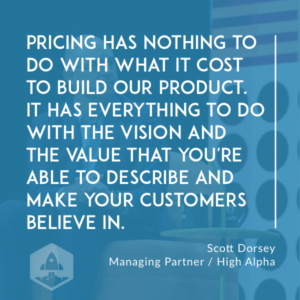
The absolute beauty of SaaS is we’re all building software, and the marginal cost of bringing an additional client on board is almost zero, so pricing really has nothing to do with what it cost to build our product. It has everything to do with the vision and the value that you’re able to describe and hopefully make your customers believers of, because they can really live into that ROI.
If you can find, early on, folks in the product management org that are really excellent at pricing and packaging, hire them. That’s it. There’s a scarcity of real experts in pricing and packaging, and it’s so imperative to your company.
I also find many early stage SaaS companies limit their flexibility by posting pricing on their site, and there are certainly models where that works extraordinarily well. When you have high velocity of new customers coming on board and using your platform, having published pricing can work very effectively.
If you’re selling more into the mid market and the enterprise and you’re just getting your start, sometimes posting pricing can really limit your flexibility, because you need to be learning, experimenting, trying lots of new things.
I like our early stage companies to not post pricing until they’re a little further down the path, and they’ve done a lot of experimentation, a lot of learning of what works, what works for each customer segment, for different vertical industries, because pricing and packaging really can be the key to having a business that’s not economically feasible, or having one that’s a runaway success.
Aaron: I want to say a few things about pricing. One thing we’ve learned here is that huge lesson. As we moved into the enterprise and started building out this enterprise’s sales force, the sales executives started to teach us about the value.
You have a theory around pricing, and you have a strategy, and you need to do research, we’ve done studies with companies, and you have that. Once you get those people out there actually talking to big customers in the right way, they teach you about the value you really have.
Tien: It could be, “I’m not sure how to talk about this value,” or it could be, “These guys are willing to pay us three times more than we’re charging. Why are we priced like this?”
Aaron: That’s right.
Scott: Exactly. We had lots of experiences where our best enterprise reps would go way beyond our rate card…
Tien: The negative discounts.
Scott: They find a new ceiling. They find a new ceiling for pricing, and then we’re able to have that inform us of where we take our pricing and packaging going forward.
Aaron: You iterate…?
Scott: Yeah, absolutely.
Aaron: …and then you figure out that sweet spot that you were referring to. The second lesson I wanted to highlight was for the land and expanders out there, we saw that we had to diverge the pricing between our B2C model and the B2B model in a very fundamental way.
We always thought that, “Hey B2B of the enterprise is just 1,000 times B2C.” It’s number of Cs times that price, and that’s the value. We want them to pay that value at the enterprise, but actually in reality, they’re willing to pay a lot more than the B2C price.
We actually didn’t see that early on. We thought that was a great thing in the end, and then, as we started to do the studies, as we started listening to our account executives, we saw that actually we’re not charging enough in the enterprise, and so we had to diverge the pricing…
Tien: You raise the per user price?
Aaron: …to bring B2C down, enterprise up on a per seat basis.
Nitsa: You guys probably saw that as we see this. When you present customers with the value model, many times they’re like, “Oh, yeah. It’s that and more.”
Aaron: Yeah. It wasn’t obvious to us, and once we started…That requires the sellers who can actually go in and sell the value, and there’s a lot more value there.
Tien: Just a quick plug. We’re actually doing a pricing and packaging seminar with our partner Simon Kucher later this month, so if you go to our website or email me, I can send more about that. It’s a topic that we’re fairly deep into.
Let’s switch to the last topic around organization. A lot of you guys were there in the early stages of the company, you wake up one day and you look around, and you’re, “We’re kind of a large company,” right? 50 million, 100 million, you’re talking 250, 500 people.
What are the organizational breakpoints? What are the new issues that you have to tackle at that phase of a company’s growth?
You have the set of employees that carried you to this place that have so much institutional knowledge that you’re incredibly loyal to. How do you know whether they’re going to be able to carry you to the next phase, and what do you guys do about that?
Aaron: That’s a big one. Over the last couple of years, we’ve gone through a lot of transition in this exact area, and it goes back to what I said earlier about not knowing what good looks like at a different scale.
I just had a phenomenal team that took us from 0 to 100 million and without any breakpoints along the way. We’re growing really fast, triple digits year over year for five, six years. We did reach a point where things did start to break a little bit.
Tien: How do you know? What are the signs?
Aaron: It was basically, you start to see growth decelerate a little bit. You start to see signs of not being able to make decisions quickly enough. Not being able to see around the corner. It’s like as I’m talking to my team and asking them the hard questions around, “OK,” like, “What do we do next?”
Not hearing through the lens of experience the ability to see around the corner of what’s coming next was when I started to realize like, “Hey, every single person in the room here with me, including me, is in the biggest job of their life.” I think that’s a sign.
Tien: That’s that moment.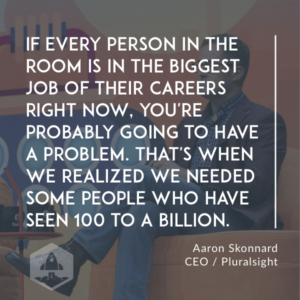
Aaron: That’s one of those milestones where you’re like if every person in the room is in the biggest job of their careers right now, you’re probably going to have a problem. That’s when we started to handle it, and look at it and realize we need some people here who have seen 100 to a billion. That was the start of the transition.
Nitsa: I think there’s a couple of things there. I think, one, with that core team, first you’re going to see some really hidden gems. Make sure that you know who those people are. I think secondly if you have a culture of…Certainly, you want a culture of achievement, but if you have a culture of improvement, and that comes from the top down, I think a lot of those people can push through.
You will need, as you bring other people in, especially if you’re in a situation where it was a strong co-founder relationship, or you guys worked together before, or you were in college together before and started this company, you got to really be mindful of making sure it doesn’t feel like it’s a club and there isn’t room at the table for these new people.
You have to be very, very prescriptive that it’s the leadership team’s responsibility to make those people successful. That’s easy for the first two weeks. Six months into it when the body wants to reject the organ, I think you need to look around the table and ask what you’re doing to make those people successful. It is a foreign… [laughs] It is a really foreign thing.
Aaron: How do you balance the new group of folks and the existing groups of folks and create some harmony?
Nitsa: Yeah, exactly. I think every person on the leadership team needs to feel really deep responsibility for that. It’s very easy to say, “Oh, that person didn’t work out because they’re not like us.” “Oh, they just didn’t get it.” I think it’s your responsibility for them to get it, which is also around alignment.
You have this thing going. You understand the framework in which and how you make decisions. You have the cultural context for it. Making sure that you have that really good alignment is critically important. You’re giving up some amount of control. With that, that’s going to be really uncomfortable.
Making sure that you feel like that person is very well aligned with how you want to think about making decisions, because you can’t make every decision for them. I think it’s also critically important.
Funny story, Peter and I literally sat together in the same little cube bullpen for I think probably about the first year that I was at the company. We got a [laughs] really good alignment, really good rhythm going as a result of that.
Scott: Just maybe two things I would add to Aaron and Nitsa’s comments. One is make sure you give all of your employees a chance to learn, and grow and develop in their roles. As Aaron said, as a founder or CEO, first time founder or CEO, you’re always in the biggest job of your life.
If you surround yourself with the right investors and board members, you’re going to grow, and develop and probably take the business to much greater heights than you ever imagined. Make sure you give that same opportunity to those across your leadership team and across your company.
I think you’ll be surprised at the capacity and ability to grow and contribute throughout the business.
Second thing I would say is when you reach the 50 or 100 million size, all of a sudden your job really changes as the CEO. You’re managing managers who are managing managers who might be managing managers. It’s very easy to get out of touch.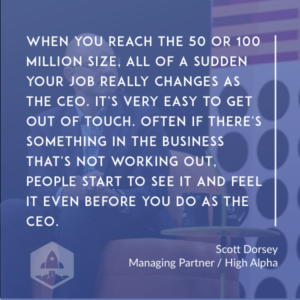
You have to build systematic ways to communicate with your executive team, your broader leadership team and all of your employees. You also need informal lines of communication where you’re staying close to the vibe and the ebb and flow of the business.
Often if there’s an executive not working out on area of the business, not working out, people start to see it and feel it maybe even before you do as the CEO. Keeping all lines of communication open and making sure the informal lines of communication are open and flowing is really imperative.
Nitsa: I’d say one thing on the board. I’m sorry.
Aaron: No, go ahead.
Nitsa: Look way ahead, way ahead to see when you’re going to have to or when you think you might need to or want to make changes to the board. Don’t get caught in a pinch and try to do that too quickly.
I think you should be very, very selective about who you put on the board and be realistic. If you’re not the best person to sell that, if it’s another board member, if it’s somebody else on the executive team, that’s fine. I think you should aim really, really high when it comes to the board and look out pretty far.
Tien: Yeah, so reinvention the board. The CEO’s job starts to change. I was on Aaron’s LinkedIn yesterday and I read his LinkedIn profile. We all go through this. I went through the same thing where at one point in the company of 200, 300 employees, I realized that my job had to change. I wanted be the listing out, what is the minimal set of things that I needed on?
I wind up with four things: evangelists, leading the line, something around functional architecture of the product and something around chief people officer. I said, “One, I can’t do anything else. Two, I’ve got to go whittle that list hopefully down to one thing or two things.”
I looked at Aaron’s LinkedIn profile and it says, “Hey, as president CEO of Pluralsight, I focus on core business strategy, future direction, product development and strategic partnership.” That’s it.
He says, “Everything else, I work closely with the rest of the Pluralsight management team.” It just resonated so much because it just felt like the same journey. Talk a little bit about that how you…
Aaron: I’m trying to whittle it down even further.
Tien: Whittle it down even further?
Aaron: Yeah. That’s the goal. I really feel like my role as a founder is to be really connected to the future of the company from a strategy perspective as an alliance to our mission. I see myself as the gatekeeper, like the protector of our mission as a company. It’s really important to me. It’s in my soul and why I created this thing.
That’s fundamentally the only thing I’m never going to give up as long as I’m still alive. I intend to protect that. Everything else can be delegated. Right now, based on the leadership that we have in place, those were the only areas that I still spend a lot of time in. It’s also still fairly minimal because I have strong leaders in each of those places.
Tien: Was that hard to get to that point?
Aaron: Yeah, it is hard. I would say that learning to let go and really empower those leaders is one of those transformation things that takes your company to the next scale. I want to add to this board comment real quick.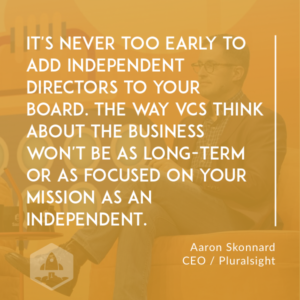
To the VC-backed companies out here, it’s never too early to add independent directors to your board. I always thought that, “Oh, that comes later once I IPO. I shouldn’t do that now. It’ll just be more complicated or add more stress to my life.” It couldn’t be further from the truth.
Tien: Not that there’s anything wrong with the VCs in the room. [laughs]
Aaron: Yeah. There is some stuff wrong with them sometimes. The way they think about the business won’t be as long term or as focused on your mission as an independent. There’s just a clear difference between that just based on the way they show up to the situation.
My recommendation would be to find those independent directors that really believe in what you’re doing, can really partner with you, align with you. That gets you more of those people who have seen bigger things, who can really help your team which is great advice. You want to give that to your executive team.
I didn’t do that to that team that I had before early enough. I didn’t have those independent directors that had that experience. That’s the role that they can play. It really changes the dialogue in the boardroom and in your strategic conversations.
All of that is connected back to this. In the end, if you have a strong board, you have a strong team with counterparts that can really help them, as the CEO, I can really focus on…
Tien: Focus on what you like to do.
Aaron: The core, which is the mission.
Tien: Good. For the entrepreneurs in the room, never let up an opportunity to poke fun at the VCs, just a general rule of entrepreneurship. We’re almost out of time. It’s a pretty diverse crowd. There are certainly people in the room that have seen 50, seen 100, there’s people who have seen a billion. There’s also a lot of folks at an earlier stage.
One thing for the crowd, the entrepreneurs out there in terms of what they have to look forward to once they get to this 50, 75, 100 million, inspire them, to cheer them on. Maybe one thing…Anything in terms of…Focus on this right now. If people are telling you to worry about this, don’t worry about it until you get to 50 million.
You got enough stress. You got enough focus. One thing that I would say, just hold off on it and you’ll get to worry about that when you get to this size. What would it be? Who wants to start? Scott?
Scott: Let me go first. OK, I’ll go first. Running a larger company can just be a blast, and a tremendous amount of fun and really rewarding. I had a conversation recently with a young entrepreneur that I just loved to pieces and really enjoyed working with him. We had a dialogue around whether he thought he will enjoy the later stages as much as the startup.
He really viewed himself as more of a startup CEO. Through that dialogue, what I shared, and I really believe in my heart, is as you get bigger and larger as an organization, it just gets to be more fun. You have more resources. You can make bigger bets. You can make a bigger difference in your employees’ lives.
You can make a bigger difference in the community in which you live. For those of you that are in the early stages of building products, and building your company and building your culture, dream big. Know that you can grow and expand into CEO of a larger enterprise.
It just continues to be rewarding and a tremendous amount of fun. You can just make a bigger difference in every aspect.
That’s maybe one bit of advice I would just share. On the what not to worry about early on… I wouldn’t worry about M&A. I wouldn’t worry about international expansion. I would try to avoid the temptation of spreading your development team across too many products. Stay focused on the big problem you’re solving and delivering extraordinary value to your customers.
Turn those customers into evangelists. Really focus on building an amazing team and building that culture. As Aaron indicated, and also Tien, culture and values really come from the top, from the CEO or from the leadership team. It’s so important to build that infrastructure right in the early days so you can take the company a long, long way.
I’ll throw in one other item too. Nitsa made a comment about building your company on the shoulders of giants.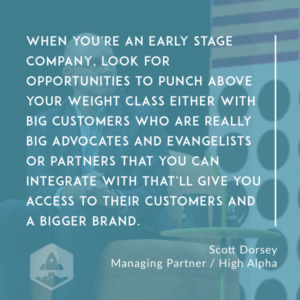
When you’re an early stage company, look for opportunities to punch above your weight class either with big customers who are really big advocates and evangelists of yours or partners that you can integrate with, that’ll give you access to their customers and a bigger brand.
I find small companies often think and operate small. You have to find partners and customers that really help you elevate your game and tell a bigger story. Ultimately, you want to develop into that category or leader.
Nitsa: I think just amplifying one thing Scott said, which we net out as focus on your own horse. You can spend a lot of time worrying about what competitors are doing or what else you should be doing. I think if you really focus and make sure that you’re committed to doing a few things.
We didn’t go out and we didn’t expand into Europe at the time at the chagrin of the board until later. We wanted to make sure that we had our early customers widely successful first. I think there’s the people within the company etc., but there’s also the temptation to spend too much time and too many cycles on competition.
I think then also to your question, but I’ll twist it a little bit, because you had said before you went public, you had in your mind the idea that you wanted to make sure, and you stumbled upon it as well. You went from SMB to enterprise.
For us, it was making sure that we were really operating. Not just had multiple products, but operating well as a multi-product company. I would say also just understand what that thing is for you and have real conviction around it. I would say build to that.
Tien: Aaron, these guys are a little bit ahead of us. We’re more at the same size. That day, month, quarter you crossed 100 million, how did it feel? Give that feeling to the entrepreneurs that are pursuing that dream.
Aaron: It felt amazing, man. It was a major milestone for the business. It’s pretty surreal. I think it’s one of those milestones where as an entrepreneur you look back and you see that so much has changed since the beginning.
Although we always believed we could get there, the fact that it actually happened is just makes it…It’s one of those amazing moments, I would say, in the journey. Do you want me to give my two, if I have time?
[laughter]
Tien: Yeah, absolutely.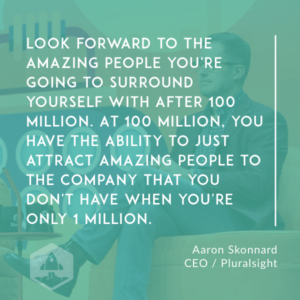
Aaron: My one thing to look forward to is the amazing people you’re going to surround yourself with after 100 million. At 100 million, you have the ability to just attract amazing people to the company that you don’t have when you’re only one million. That continues to grow the bigger the company gets. I’ve just noticed that.
The talent you can recruit. The people you’d have on your board. The partnerships you’re able to establish. The CEO relationships I’m able to cultivate now. Those things are just wonderful.
They make me a better CEO. You’ll get that at 100 million. The thing I would counsel to not worry about is the little stuff.
Don’t worry about doing it the “right way.” We never did anything the right way at Pluralsight. We didn’t even have an HR team for the first 10 years of the company. Everyone’s telling us, “You need HR, you need HR.” We’re like, “Well, we’ll just figure it out.” Like, “It’s OK.” We didn’t do HR for the first 10 years of the company and here we are.
There’s a lot of things that may or may not be important to you. Figure out what the little stuff is for you and don’t sweat it. Focus on the product. Focus on growth. Focus on that product market fit. The rest will take care of itself at the right time.
Tien: Good, fantastic. Amazing panelists, amazing companies, amazing executives, amazing people. Just the last word is the 0 to 100 million, what SaaStr is all about. I can think of no greater vehicle for personal development in this life for fun. I congratulate everybody in the audience for what they’re doing. Thank you very much.
Aaron: Thanks, guys.
Scott: Thank you.
[applause]
Tien: I am out of here.
[music]
Transcription by CastingWords

